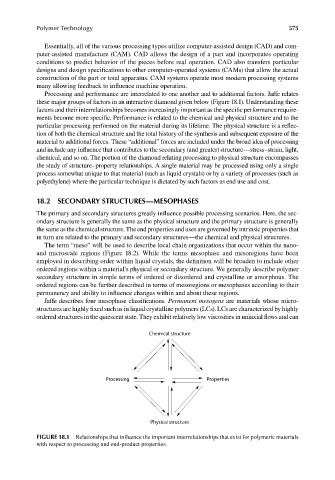Page 612 - Carrahers_Polymer_Chemistry,_Eighth_Edition
P. 612
Polymer Technology 575
Essentially, all of the various processing types utilize computer-assisted design (CAD) and com-
puter-assisted manufacture (CAM). CAD allows the design of a part and incorporates operating
conditions to predict behavior of the pieces before real operation. CAD also transfers particular
designs and design specifications to other computer-operated systems (CAMs) that allow the actual
construction of the part or total apparatus. CAM systems operate most modern processing systems
many allowing feedback to influence machine operation.
Processing and performance are interrelated to one another and to additional factors. Jaffe relates
these major groups of factors in an interactive diamond given below (Figure 18.1). Understanding these
factors and their interrelationships becomes increasingly important as the specific performance require-
ments become more specifi c. Performance is related to the chemical and physical structure and to the
particular processing performed on the material during its lifetime. The physical structure is a refl ec-
tion of both the chemical structure and the total history of the synthesis and subsequent exposure of the
material to additional forces. These “additional” forces are included under the broad idea of processing
and include any influence that contributes to the secondary (and greater) structure—stress–strain, light,
chemical, and so on. The portion of the diamond relating processing to physical structure encompasses
the study of structure–property relationships. A single material may be processed using only a single
process somewhat unique to that material (such as liquid crystals) or by a variety of processes (such as
polyethylene) where the particular technique is dictated by such factors as end use and cost.
18.2 SECONDARY STRUCTURES—MESOPHASES
The primary and secondary structures greatly influence possible processing scenarios. Here, the sec-
ondary structure is generally the same as the physical structure and the primary structure is generally
the same as the chemical structure. The end properties and uses are governed by intrinsic properties that
in turn are related to the primary and secondary structures—the chemical and physical structures.
The term “meso” will be used to describe local chain organizations that occur within the nano-
and microscale regions (Figure 18.2). While the terms mesophase and mesoregions have been
employed in describing order within liquid crystals, the definition will be broaden to include other
ordered regions within a material’s physical or secondary structure. We generally describe polymer
secondary structure in simple terms of ordered or disordered and crystalline or amorphous. The
ordered regions can be further described in terms of mesoregions or mesophases according to their
permanency and ability to influence changes within and about these regions.
Jaffe describes four mesophase classifi cations. Permanent mesogens are materials whose micro-
structures are highly fixed such as in liquid crystalline polymers (LCs). LCs are characterized by highly
ordered structures in the quiescent state. They exhibit relatively low viscosities in uniaxial flows and can
Chemical structure
Processing Properties
Physical structure
FIGURE 18.1 Relationships that influence the important interrelationships that exist for polymeric materials
with respect to processing and end-product properties.
9/14/2010 3:43:35 PM
K10478.indb 575
K10478.indb 575 9/14/2010 3:43:35 PM

